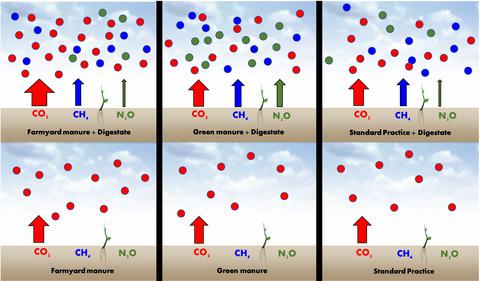当前位置:
X-MOL 学术
›
GCB Bioenergy
›
论文详情
Our official English website, www.x-mol.net, welcomes your
feedback! (Note: you will need to create a separate account there.)
Legacy effects override soil properties for CO2 and N2O but not CH4 emissions following digestate application to soil.
Global Change Biology Bioenergy ( IF 5.9 ) Pub Date : 2020-04-27 , DOI: 10.1111/gcbb.12688 Maria Chiara Rosace 1 , Fabio Veronesi 1 , Stephen Briggs 2 , Laura M Cardenas 3 , Simon Jeffery 1
Global Change Biology Bioenergy ( IF 5.9 ) Pub Date : 2020-04-27 , DOI: 10.1111/gcbb.12688 Maria Chiara Rosace 1 , Fabio Veronesi 1 , Stephen Briggs 2 , Laura M Cardenas 3 , Simon Jeffery 1
Affiliation

|
The application of organic materials to soil can recycle nutrients and increase organic matter in agricultural lands. Digestate can be used as a nutrient source for crop production but it has also been shown to stimulate greenhouse gas (GHG) emissions from amended soils. While edaphic factors, such as soil texture and pH, have been shown to be strong determinants of soil GHG fluxes, the impact of the legacy of previous management practices is less well understood. Here we aim to investigate the impact of such legacy effects and to contrast them against soil properties to identify the key determinants of soil GHG fluxes following digestate application. Soil from an already established field experiment was used to set up a pot experiment, to evaluate N2O, CH4 and CO2 fluxes from cattle‐slurry‐digestate amended soils. The soil had been treated with farmyard manure, green manure or synthetic N‐fertilizer, 18 months before the pot experiment was set up. Following homogenization and a preincubation stage, digestate was added at a concentration of 250 kg total N/ha eq. Soil GHG fluxes were then sampled over a 64 day period. The digestate stimulated emissions of the three GHGs compared to controls. The legacy of previous soil management was found to be a key determinant of CO2 and N2O flux while edaphic variables did not have a significant effect across the range of variables included in this experiment. Conversely, edaphic variables, in particular texture, were the main determinant of CH4 flux from soil following digestate application. Results demonstrate that edaphic factors and current soil management regime alone are not effective predictors of soil GHG flux response following digestate application. Knowledge of the site management in terms of organic amendments is required to make robust predictions of the likely soil GHG flux response following digestate application to soil.
中文翻译:

沼渣施用到土壤后,遗留效应会影响 CO2 和 N2O 的土壤特性,但不会影响 CH4 排放。
有机材料应用于土壤可以回收养分并增加农田的有机质。沼渣可用作作物生产的营养源,但它也被证明会刺激改良土壤的温室气体 (GHG) 排放。虽然土壤质地和 pH 值等土壤因素已被证明是土壤温室气体通量的重要决定因素,但先前管理实践的影响尚不清楚。在这里,我们的目标是研究此类遗留效应的影响,并将其与土壤特性进行对比,以确定沼渣施用后土壤温室气体通量的关键决定因素。来自已建立的田间实验的土壤被用来建立盆栽实验,以评估来自牛泥消化物改良土壤的 N 2 O、CH 4和 CO 2通量。盆栽试验前18个月,用农家肥、绿肥或合成氮肥对土壤进行处理。在均质化和预孵育阶段之后,以 250 kg 总氮/公顷当量的浓度添加消化物。然后对 64 天的土壤温室气体通量进行了采样。与对照相比,沼渣刺激了三种温室气体的排放。研究发现,先前土壤管理的遗留问题是 CO 2和 N 2 O 通量的关键决定因素,而土壤变量在本实验所包含的变量范围内没有显着影响。相反,土壤变量,特别是质地,是沼渣施用后土壤中 CH 4通量的主要决定因素。 结果表明,土壤因素和当前的土壤管理制度本身并不能有效预测沼渣施用后土壤温室气体通量的响应。需要了解有机改良方面的场地管理知识,才能对沼渣施用到土壤后可能产生的土壤温室气体通量响应做出可靠的预测。
更新日期:2020-04-27
中文翻译:

沼渣施用到土壤后,遗留效应会影响 CO2 和 N2O 的土壤特性,但不会影响 CH4 排放。
有机材料应用于土壤可以回收养分并增加农田的有机质。沼渣可用作作物生产的营养源,但它也被证明会刺激改良土壤的温室气体 (GHG) 排放。虽然土壤质地和 pH 值等土壤因素已被证明是土壤温室气体通量的重要决定因素,但先前管理实践的影响尚不清楚。在这里,我们的目标是研究此类遗留效应的影响,并将其与土壤特性进行对比,以确定沼渣施用后土壤温室气体通量的关键决定因素。来自已建立的田间实验的土壤被用来建立盆栽实验,以评估来自牛泥消化物改良土壤的 N 2 O、CH 4和 CO 2通量。盆栽试验前18个月,用农家肥、绿肥或合成氮肥对土壤进行处理。在均质化和预孵育阶段之后,以 250 kg 总氮/公顷当量的浓度添加消化物。然后对 64 天的土壤温室气体通量进行了采样。与对照相比,沼渣刺激了三种温室气体的排放。研究发现,先前土壤管理的遗留问题是 CO 2和 N 2 O 通量的关键决定因素,而土壤变量在本实验所包含的变量范围内没有显着影响。相反,土壤变量,特别是质地,是沼渣施用后土壤中 CH 4通量的主要决定因素。 结果表明,土壤因素和当前的土壤管理制度本身并不能有效预测沼渣施用后土壤温室气体通量的响应。需要了解有机改良方面的场地管理知识,才能对沼渣施用到土壤后可能产生的土壤温室气体通量响应做出可靠的预测。











































 京公网安备 11010802027423号
京公网安备 11010802027423号